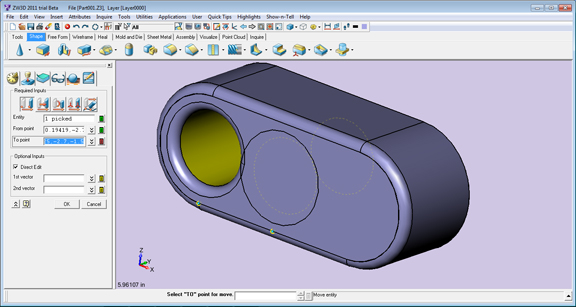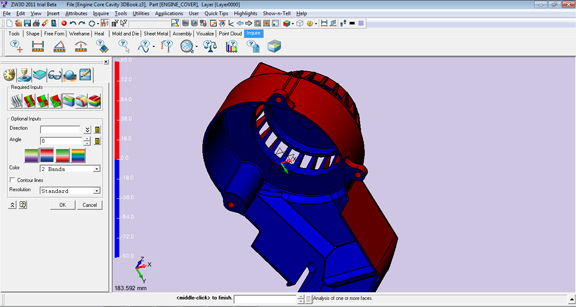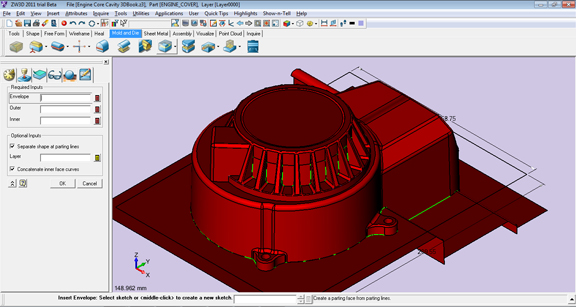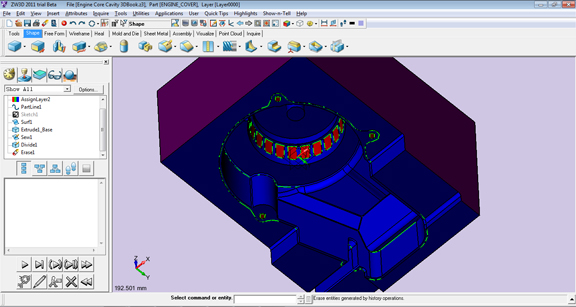Latest News
May 5, 2011


If you’re familiar with, or have used, VX CAD/CAM, your encounter with ZWSoft’s ZW3D may feel more like a reunion with an old friend, but in a new outfit. ZW3D is a 2D/3D MCAD package (“all in one CAD/CAM” as the company calls it), which combines drafting features from ZWSoft’s AutoCAD-clone ZWCAD and modeling features from VX CAD/CAM. (ZWSoft acquired VX CAD/CAM in April 2010.) This makes ZW3D the offspring of not just two different technologies but two different cultures: ZWSoft is headquartered in Guangzhou, the manufacturing heartland of China; VX CAD/CAM was an American brand, based in Melbourne, by the Florida Space Coast.
ZW3D 2011, now available as a beta download, offers a wide range of 2D and 3D commands, along with tools for sheet metal design, freeform modeling, mold and die (core and cavity) creation, and point-cloud processing. In 3D mode, the software gives you the option to drag and move faces and features from their original positions to new destinations. To perform most operations, however, you must still follow the classic parametric modeling protocols. If you’re a first-time user, it may take some time to become familiar with the software’s menus, dialog boxes, and input fields. So don’t expect to be able to quickly get up to speed as you might with some direct-editing packages, like SpaceClaim, Autodesk Inventor Fusion, or Solid Edge with Synchronous Technology.


Perhaps most notable is the software’s Mold and Die tool set, which gives you what you need to create core and cavity blocks from your CAD geometry. You may use the tools under this tab to automatically identify parting lines for your mold blocks, generate parting faces, then create the basic block that can be split into core and cavity.
A few functions may even be consolidated in future releases to make the process simpler. For instance, in the current version, after generating your parting faces, you still need to manually patch them together into a single surface (most likely, you’ll use the Sew function under the Heal tab), which you’ll later use as the cutting plane to divide your mold block. But I don’t see any reason why these surfaces cannot automatically be merged into a single sheet once they’ve been generated.
The software also comes with a built-in rendering application, called POV-Ray. It does an admirable job, but it’s not as extensive as the rendering apps found in SolidWorks, Inventor, or Solid Edge. Currently, rendering in ZW3D satisfies your most basic needs. To effectively compete with rivals, ZW3D will need to provide additional features, such as a library of preloaded textures, materials, backgrounds, and environments.
ZW3D comes in three versions: $2,500 for standard; $4,000 for professional; and $7,000 for premium. To get access to mold and die design and point-cloud processing features, you’ll need the professional version. To get access to CNC functions and milling operations, you’ll need the premium version.
For second release, ZW3D proves to be a comprehensive CAD/CAM program. Since its 3D modeling technology is based on VX CAD/CAM, even though the brand ZW3D may be new, the modeling engine is a robust, reliable, stable one. The additional mold, die, machining, and CNC features it offers makes ZW3D a strong contender. The little details—like the option to extrude your profile into a solid with a draft angle—indicates the software’s legacy (via VX CAD/CAM) in manufacturing, mold making, and machining. In future releases, if the software returns with a simpler interface and stronger real-time rendering tools, it could quickly become a package on the short list of preferred CAD modelers for many.
For more, watch the video report below:
Subscribe to our FREE magazine, FREE email newsletters or both!
Latest News
About the Author
Kenneth Wong is Digital Engineering’s resident blogger and senior editor. Email him at [email protected] or share your thoughts on this article at digitaleng.news/facebook.
Follow DE





